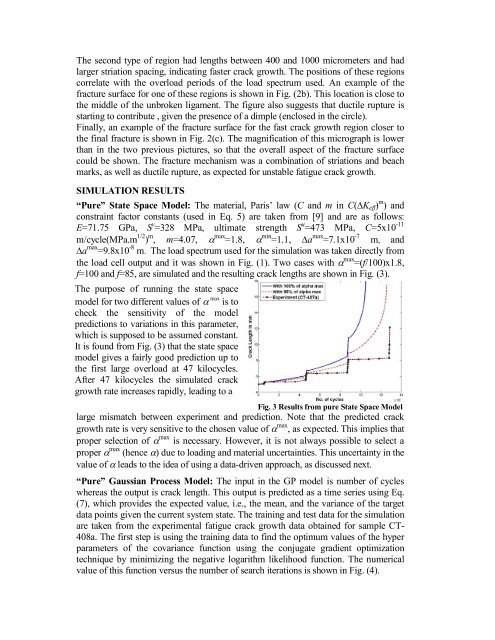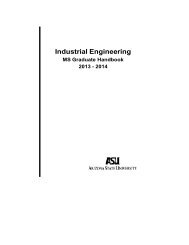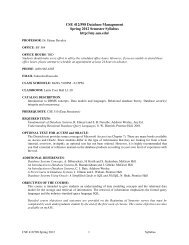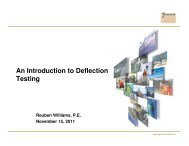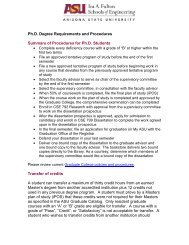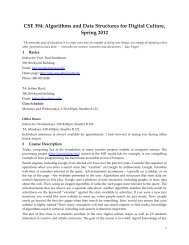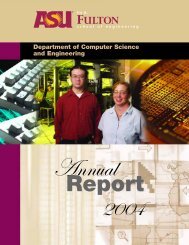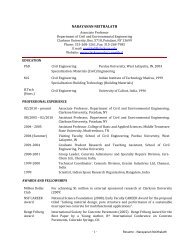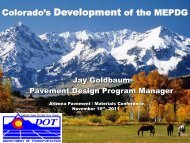Mixed Gaussian Process and State-Space Approach for Fatigue ...
Mixed Gaussian Process and State-Space Approach for Fatigue ...
Mixed Gaussian Process and State-Space Approach for Fatigue ...
Create successful ePaper yourself
Turn your PDF publications into a flip-book with our unique Google optimized e-Paper software.
The second type of region had lengths between 400 <strong>and</strong> 1000 micrometers <strong>and</strong> hadlarger striation spacing, indicating faster crack growth. The positions of these regionscorrelate with the overload periods of the load spectrum used. An example of thefracture surface <strong>for</strong> one of these regions is shown in Fig. (2b). This location is close tothe middle of the unbroken ligament. The figure also suggests that ductile rupture isstarting to contribute , given the presence of a dimple (enclosed in the circle).Finally, an example of the fracture surface <strong>for</strong> the fast crack growth region closer tothe final fracture is shown in Fig. 2(c). The magnification of this micrograph is lowerthan in the two previous pictures, so that the overall aspect of the fracture surfacecould be shown. The fracture mechanism was a combination of striations <strong>and</strong> beachmarks, as well as ductile rupture, as expected <strong>for</strong> unstable fatigue crack growth.SIMULATION RESULTS“Pure” <strong>State</strong> <strong>Space</strong> Model: The material, Paris’ law (C <strong>and</strong> m in C(∆K eff ) m ) <strong>and</strong>constraint factor constants (used in Eq. 5) are taken from [9] <strong>and</strong> are as follows:E=71.75 GPa, S y =328 MPa, ultimate strength S u =473 MPa, C=5x10 -11m/cycle(MPa.m 1/2 ) m , m=4.07, max =1.8, min =1.1, ∆a max =7.1x10 -7 m, <strong>and</strong>∆a max =9.8x10 -8 m. The load spectrum used <strong>for</strong> the simulation was taken directly fromthe load cell output <strong>and</strong> it was shown in Fig. (1). Two cases with max =(f/100)x1.8,f=100 <strong>and</strong> f=85, are simulated <strong>and</strong> the resulting crack lengths are shown in Fig. (3).The purpose of running the state spacemaxmodel <strong>for</strong> two different values of is tocheck the sensitivity of the modelpredictions to variations in this parameter,which is supposed to be assumed constant.It is found from Fig. (3) that the state spacemodel gives a fairly good prediction up tothe first large overload at 47 kilocycles.After 47 kilocycles the simulated crackgrowth rate increases rapidly, leading to aFig. 3 Results from pure <strong>State</strong> <strong>Space</strong> Modellarge mismatch between experiment <strong>and</strong> prediction. Note that the predicted crackgrowth rate is very sensitive to the chosen value of max , as expected. This implies thatproper selection of max is necessary. However, it is not always possible to select aproper max (hence ) due to loading <strong>and</strong> material uncertainties. This uncertainty in thevalue of leads to the idea of using a data-driven approach, as discussed next.“Pure” <strong>Gaussian</strong> <strong>Process</strong> Model: The input in the GP model is number of cycleswhereas the output is crack length. This output is predicted as a time series using Eq.(7), which provides the expected value, i.e., the mean, <strong>and</strong> the variance of the targetdata points given the current system state. The training <strong>and</strong> test data <strong>for</strong> the simulationare taken from the experimental fatigue crack growth data obtained <strong>for</strong> sample CT-408a. The first step is using the training data to find the optimum values of the hyperparameters of the covariance function using the conjugate gradient optimizationtechnique by minimizing the negative logarithm likelihood function. The numericalvalue of this function versus the number of search iterations is shown in Fig. (4).


